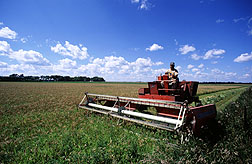This page has been archived and is being provided for reference purposes only. The page is no longer being updated, and therefore, links on the page may be invalid.
|
|
Growers Can Make More Money by Going Organic
By Don ComisJuly 25, 2006
It looks like Minnesota grain farmers could make more money by switching to organic grain crops. That's the conclusion of a four-year study being announced today at the American Agricultural Economics Association's annual meeting in Long Beach, Calif.
David W. Archer, an Agricultural Research Service (ARS) economist, and Hillarius Kludze, an ARS soil scientist, will present a paper on this study, conducted at the Swan Lake Research Farm near Morris, Minn. The study was unusual in that it analyzed both economic risks and transition effects of switching to organic farming.
The 130-acre Swan Lake farm is representative of typical corn-soybean farms in Minnesota. The ARS North Central Soil Conservation Research Lab in Morris leases this farm for field research from the local Barnes-Aastad Soil and Water Conservation Research Association.
Archer and Kludze compared an organic corn-soybean rotation and an organic corn-soybean-spring wheat/alfalfa rotation—half grown with conventional tillage and half with strip tillage—with a corn-soybean rotation using conventional tillage. Strip tillage involves tilling only the middle of the seedbed. The scientists found that when strip tillage is used with organic farming, one of the transition risks is an increase in weeds until farmers learn to manage the system.
Computer simulations projected costs, yields and risks over a 20-year period, using yield and economic data from the four-year study, as well as crop price records of recent years.
Records showed that organic crops fetched much more than conventional crops: soybeans, up to $14 more per bushel; corn, up to $3 more; and wheat, up to $5 more. Organic alfalfa hay is too new to have a track record, so researchers recorded it as selling for the same price as conventionally grown hay.
Another computer model projected that farmers would net an average $50 to $60 more per acre a year by going organic, even with the highest transition costs. The premium price advantage would outweigh the initial higher costs and possibly lower yields, even if organic prices were to drop by half.
ARS is the U.S. Department of Agriculture's chief scientific research agency.

